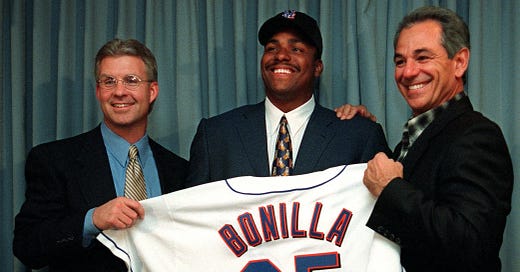This Thursday, like every July 1st until 2035, the Mets will write a check to Bobby Bonilla for a comically specific amount of money ($1,193,248.20), despite the fact that Bonilla has not played professional baseball since 2001, and has not played for the Mets since 1999. It’s known as “Bobby Bonilla Day,” and is commemorated by fans to the point that new Mets owner Steve Cohen floated the idea of having a ceremony for the occasion last November.
The fact that a capitalist creep like Cohen can joke about Bobby Bonilla Day should tell you that something is up—because the whole thing is profoundly anti-labor. The subtext of every joke and tweet and TV segment is, “Look at those stupid Mets, forced to pay a player like Bonilla for a quarter of a century.” The point is to make Bonilla look like he is laughing all the way to the bank, while the hapless Mets turn out their pockets.
But this is bullshit. The Bobby Bonilla deal was a GOOD deal for the Mets, not a bad one. Rather than having to pay Bonilla the $5.9 million they owed him for the 2000 season, they were able to defer their payments over 35 years. In effect, Bonilla was lending the Mets almost $6 million, and not collecting anything on that loan for over ten years. If someone offered you $6 million on those terms, you would be crazy to say no.
The reason it looks like a bad deal at first glance is that the total amount the Mets will end up paying Bonilla--$29,831,205—is a lot more than the $5,900,000 they initially owed him. But that’s the funny thing about compound interest: If you let interest accrue for 35 years, it starts to add up. And the interest rate Bonilla charged the Mets—8%–is not unreasonable. It’s often suggested that the reason the Mets were duped into the Bonilla deal is that at the time the Wilpons were clients of Bernie Madoff, who was fabricating unreasonably high returns for his investors, but even this is another way of making the Mets seem like innocent simpletons: You don’t need some kind of investing genius to beat a return of 8% per year—the average annual rate of return on the S&P 500 is between 8-10%. The Mets could have put the salary they saved on Bonilla into an index fund and still come out ahead on the deal.*
*Actually, if they had done this at the exact moment they made the deal with Bonilla, and withdrawn it at exactly the time his first payment was due, they would have lost money, since they’d be buying into the stock market at the precisely the peak of the 2000 Internet bubble and selling during the fallout from the 2008 financial crisis… Averages are only averages. But the point stands: The Mets did not have to expect some unreasonable return to earn 8% a year. They merely had to get an historically average return on an investment over a 10-year period.
But even this understates the case. Because the Mets are not a pension fund—they don’t exist purely to generate a reliable return on their investment. The Mets are a baseball team, and the goal of a baseball team is to win games and championships. Getting rid of Bonilla helped them do that. When they traded for him in 1999, it was a risk worth taking—Bonilla was still a consistent hitter at that point, and all the Mets gave up in the trade was Mel Rojas, a relief pitcher who’d throw only 14 innings in the 1999 season, giving up 28 runs. Of course, Bonilla was also bad in 1999, but by getting him to defer his salary the next year, the Mets freed up $5.9 million for the 2000 season. That was almost exactly what they needed to take on the salary of Mike Hampton, who became their best pitcher and finished second on the team in Wins Above Replacement. Hampton was also the NLCS MVP that year, leading the Mets to their first World Series since 1986. On top of all that, when Hampton signed with the Colorado Rockies a year later, the Mets used their compensatory pick to select David fucking Wright.
In other words, by making the deal with Bobby Bonilla, the Mets were able to make a World Series and draft a franchise player. And all they had to do was pay an interest rate slightly lower than you would’ve gotten on a 30-year fixed mortgage at the time.
So what the hell is the problem? The only reason anyone makes a big deal about Bobby Bonilla Day—aside from confusion about compound interest—is that some people, especially owners, like to make it seem as if players are pulling one over on the owners every time they get a check. Every year these people shake their heads, laugh, and say “lol Mets” or “Can you believe they fell for that?” or even “Good for Bobby Bonilla, taking advantage of their stupidity.” In every case, the suggestion is always that it’s Bonilla who came out ahead, and that the only a reason a player might make a lot of money is that some hapless team made a stupid mistake.
Of course, Bonilla certainly made out well. He’s effectively getting a pension of $1.2 million per year into his mid-70s, which is a pretty enviable retirement. But the idea that a well-compensated worker is ever compatible with good business sense is a dangerous one for capitalists to let out. Better to make an annual holiday out of how “dumb” the Mets are than acknowledge that paying someone well for a subpar season is ever less than catastrophic.



